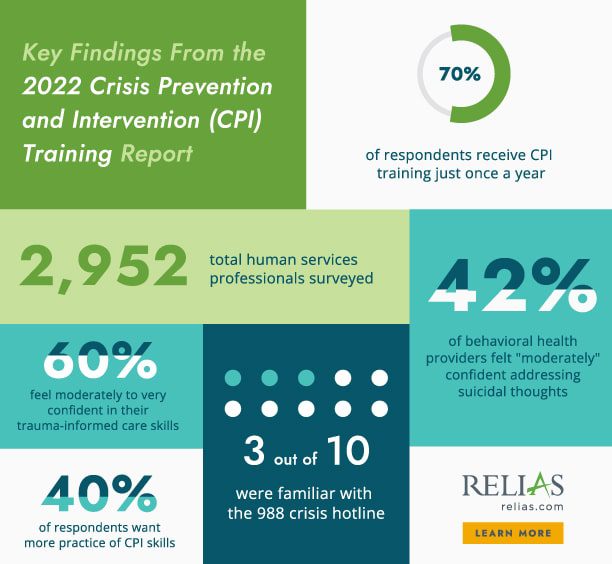Since the beginning of the COVID-19 pandemic, Americans’ mental health has been negatively impacted in several ways. The rates of anxiety and depression in the U.S. have grown considerably, leading many experts to worry about a potential rise in crisis situations such as suicidal ideation, overdoses, and domestic violence. The ability of your staff to mitigate various types of crises has never been more important. The performance of your staff members, however, is closely linked to the quality of training they receive. The multifaceted challenges that human services organizations have contended with over the last several years have only further accentuated the importance of strategic planning for crisis prevention and intervention training.
To gain insight into the current state of training for crisis prevention and intervention among behavioral health and intellectual and developmental disability (IDD) professionals, Relias conducted a survey of over 2,000 human services professionals.
Here, we’ll review the high-level insights on crisis prevention and intervention training that this survey yielded to help learning and development leaders improve how they train their staff to mitigate crisis situations.
What We Mean by Crisis Prevention and Intervention
Before we analyze the results of the survey — the first of its kind by Relias — let’s quickly define key terms we’ll use throughout the article. In our survey, we questioned participants on training across various types of crisis prevention, intervention, and postvention techniques, and how their organizations facilitate crisis prevention and intervention training.
We differentiate these techniques as follows:
- Prevention — stopping the crisis before it happens — for example, counseling a child whose parents are going through divorce proceedings and helping them to navigate their emotions through the process.
- Intervention — mitigating a crisis situation so that it does not continue to escalate or cause permanent damage to the individual experiencing crisis — for example, effectively providing verbal de-escalation to someone threatening to harm themselves.
- Postvention — an organized response following a crisis to ensure that those affected get the care they need — for example, working with a client who survived a suicide attempt, and helping them to address the issues that led to their crisis experience.
The way that behavioral health and IDD professionals implement these crisis techniques can have a huge impact on the well-being of clients. To that end, it is crucial to ensure proper training around crisis prevention, intervention, and postvention techniques.
What Our Survey Uncovered About Crisis Training
Our survey which informed the 2022 Crisis Prevention and Intervention Training Report uncovered some interesting trends across the human services industry, most notably:
- Most respondents use crisis prevention and intervention skills in their primary roles on a regular basis, yet only receive training on these skills once a year.
- Online training, especially blended learning, is a popular method of enhancing crisis prevention and intervention skills and increasing staff confidence.
- Most IDD professionals avoid using physical intervention as a response, indicating a potential increase in positive behavior supports in this field.
- The majority of human services staff was unaware of 988, the new national number for suicide prevention and behavioral health crisis response. At the time of our survey (four months prior to the launch of 988), over 80% of respondents felt unfamiliar with the topic.
Let’s look at each of these points in greater detail.
Roles and Expertise
Before we can effectively gauge the role that crisis prevention and intervention training plays among human services professionals, we have to understand how they practice crisis management in their roles. To that end, we asked respondents if crisis prevention, intervention, and/or postvention make up part of their duties.
A majority (60%) of survey respondents in behavioral health settings and 40% of those in IDD settings indicated that crisis prevention constituted part of their primary roles. An additional 24% of behavioral health respondents reported using crisis prevention and intervention skills every day.
Despite the importance of these skills to their everyday job, however, most respondents reported that they only receive training on crisis topics once a year.
This is interesting as research has shown that more frequent training leads to greater information retention.
Crisis Prevention and Intervention Training Options
Though most respondents only receive crisis prevention and intervention training once per year, the high demand for these skills in today’s workforce has led to a variety of training modalities becoming available.
 While an organization’s training choice depends on a variety of factors, most respondents reported that their organization uses some form of online training most of the time. For example, of those respondents trained in crisis intervention/management, 27% received blended learning, 26% received online pre-recorded learning, and 20% received online live learning. This means that 73% of respondents trained on this topic received some portion of their training online.
While an organization’s training choice depends on a variety of factors, most respondents reported that their organization uses some form of online training most of the time. For example, of those respondents trained in crisis intervention/management, 27% received blended learning, 26% received online pre-recorded learning, and 20% received online live learning. This means that 73% of respondents trained on this topic received some portion of their training online.
This trend held true across all training topics, as the majority of crisis prevention and intervention topics were taught via some element of online training, whether it be online live training, online e-learning, or a blend of live training and online training.
Additionally, a majority of respondents indicated that in order to increase their confidence in their crisis prevention and intervention skills, they would want more practice of these skills, more continuing education opportunities, and a wider variety of training options.
Choice of Interventions
To understand how staff members incorporate what they learn during their crisis prevention and intervention training, we asked respondents how they practice crisis prevention, intervention, and postvention.
The most notable result came from respondents working in IDD services.
Interestingly, we found a notable lack of physical interventions used by IDD respondents. While over 50% of respondents’ organizations allow for the use of physical interventions, over 80% of respondents told us they don’t use them.
Historically speaking, physical interventions were the norm in this field for a long time. This downward trend in their use seems to indicate a growth in prevention techniques such as positive behavior supports.
Preparation for the 988 Hotline
Implemented in July 2022, the 988 hotline was created to increase access to behavioral healthcare and crisis intervention services nationwide. Similar to 911, users can dial 988 and receive an emergency response from trained behavioral health specialists. Experts hope this will increase access to necessary behavioral healthcare while decreasing unnecessary interactions with law enforcement, mitigating further trauma for those in crisis.
emergency response from trained behavioral health specialists. Experts hope this will increase access to necessary behavioral healthcare while decreasing unnecessary interactions with law enforcement, mitigating further trauma for those in crisis.
Despite the potential of 988 to mitigate crises, our survey found a general lack of knowledge around 988. When we conducted our survey, close to 80% of respondents reported they were not familiar with the hotline.
Although we conducted this survey several months before the launch of the 988 hotline, this finding indicates the importance of training your staff on crisis intervention supports or working with clients who may be referred to your organization after utilizing 988.
Take Your Crisis Prevention Training to the Next Step
To help you as a leader in human services develop a training plan to meet the crisis prevention and intervention training needs of your staff, we’ve put together the following recommendations.
- Increase the frequency of training. While the majority of human services organizations require crisis prevention and intervention training at least once annually, Relias found that increasing the frequency of crisis prevention and intervention training positively impacts provider confidence in their crisis management skills. Additionally, consider offering staff greater access to training in particular aspects of crisis prevention and intervention, such as suicide prevention, trauma-informed care, and verbal de-escalation of crises.
- Perform more blended learning. Respondents continually reported online-based learning as their most used means of training, with blended learning often ranking as the most common modality. Blended learning offers your staff access to a wider variety of training options, as the online portion of these trainings can involve live or pre-recorded lectures, quizzes to increase information retention, and more.
- Consider simulation courses. Similar to blended learning, simulation courses can help your staff gain access to wider varieties of training, while also giving them a safe, risk-free environment in which to practice newly learned skills. Indeed, respondents continuously told us that more practice of the skills they learn in crisis prevention and intervention training would help to improve their confidence. Simulation courses can do just that.
- Educate staff on 988. While 988 rolled out in July 2022, at the time of this survey about four months prior, very few providers knew what 988 was and that 988 is intended to expand access to crisis services. As you train your staff members on crisis prevention and intervention, make sure they are aware of 988 and how it may increase demand for your services.
2022 Crisis Prevention and Intervention Training Report
Reserve your copy of the 2022 Crisis Prevention and Intervention Training Report to unlock insights into the state of crisis prevention and intervention training, the most widely used types of training, which types of training staff want more of, and more.
Reserve Your Copy →






